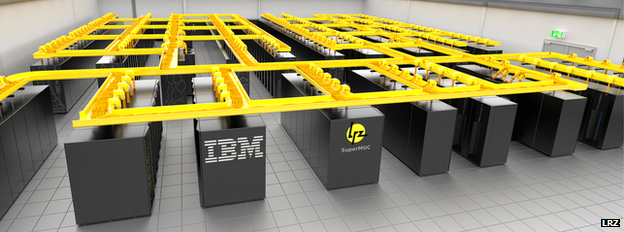IBM unveils concept for a future brain-inspired 3D computer
October 20, 2013
[+]
IBM has unveiled a prototype of a new brain-inspired computer powered by what it calls “electronic blood,” BBC News reports.
IBM Zurick’s vision of a 3D computer (credit: IBM Zurich)
The firm says it is learning from nature by building computers fueled and cooled by a liquid, like our minds.
The human brain packs phenomenal computing power into a tiny space and uses only 20 watts of energy – an efficiency IBM is keen to match.
Its new “redox flow” system pumps an electrolyte “blood” through a computer, carrying power in and taking heat out.
A very basic model was demonstrated this week at IBM’s Zurich lab by Dr. Patrick Ruch and Dr. Bruno Michel.
A sugar-cube-size supercomputerTheir vision is that by 2060, a one petaflop computer that would fill half a football field today will fit inside a sugarcube. To do that, we need a paradigm shift in electronics — we need to be motivated by our brain,” says Michel.
“The human brain is 10,000 times more dense and efficient than any computer today.
“That’s possible because it uses only one — extremely efficient — network of capillaries and blood vessels to transport heat and energy — all at the same time.”
Energy efficiency — not raw computing power — is the guiding principle for the next generation of computer chips, IBM believes.
Our current 2D silicon chips, which for half a century have doubled in power through Moore’s Law, are approaching a physical limit where they cannot shrink further without overheating.
Michel’s vision is for a new “bionic” computing architecture,
inspired by one of the laws of nature — allometric scaling — where an
animal’s metabolic power increases with its body size.The first is 3D architecture, with chips stacked high, and memory storage units interwoven with processors.
Liqud cooling
IBM’s solution is integrated liquid cooling, where chips are interlayered with tiny water pipes.
The art of liquid cooling has been demonstrated by Aquasar and put to work inside the German supercomputer SuperMUC which harnesses warm water to cool its circuits. I consumes 40% less electricity as a result.

SuperMUC uses liquid cooling instead of air —a model for future computer designs (credit: IBM Zurich)
Just as blood gives sugar in one hand and takes heat with another, IBM is looking for a fluid that can multitask.
“To power a zettascale computer today would take more electricity than is produced in the entire world,” says Michel.
“Just as computers help us understand our brains, if we understand our brains we’ll make better computers,” says director Matthias Kaiserswerth.
He would like to see a future Watson win Jeopardy on a level playing field.
(¯`*• Global Source and/or more resources at http://goo.gl/zvSV7 │ www.Future-Observatory.blogspot.com and on LinkeIn Group's "Becoming Aware of the Futures" at http://goo.gl/8qKBbK │ @SciCzar │ Point of Contact: www.linkedin.com/in/AndresAgostini
 Washington
Washington